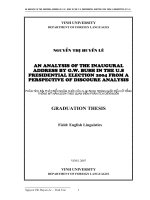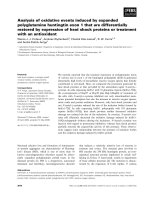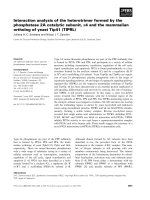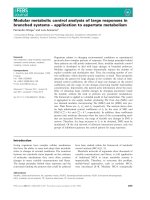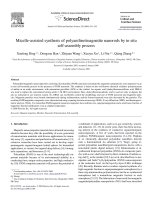Analysis of volatile compounds of Jasminum nitidum [Acc.JN.1] flowers
Bạn đang xem bản rút gọn của tài liệu. Xem và tải ngay bản đầy đủ của tài liệu tại đây (234.04 KB, 7 trang )
<span class='text_page_counter'>(1)</span><div class='page_container' data-page=1>
<i><b>Int.J.Curr.Microbiol.App.Sci </b></i><b>(2017)</b><i><b> 6</b></i><b>(11): 5411-5418 </b>
5411
<b>Original Research Article </b> />
<b>Analysis of Volatile Compounds of </b>
<i><b>Jasminum nitidum</b></i>
<b> [Acc.JN.1] Flowers </b>
<b>P. Ranchana*, M. Ganga, M. Jawaharlal and M. Kannan </b>
Department of Floriculture and Landscaping, HC& RI, TNAU,
Coimbatore- 3, Tamil Nadu, India
<i>*Corresponding author </i>
<i><b> </b></i> <i><b> </b></i><b>A B S T R A C T </b>
<i><b> </b></i>
<b>Introduction </b>
Jasmine is one of the most popular and
important traditional loose flowers grown in
India. Three species of jasmine <i>viz., </i>
<i>Jasminum sambac</i>, <i>Jasminum auriculatum</i>
and <i>Jasminum grandiflorum </i>are cultivated in
a commercial scale (Rimando, 2003; Green
and Miller, 2009). It holds a vital place in all
the religious, social and cultural activities of
the Indian society. Jasmine flowers have
multifarious uses including use as fresh
flowers for garland making for adorning hair
of women and in religious offerings and also
for extraction of its highly valued essential oil
which is popularly used in the perfumery
industry. Tamil Nadu Agricultural University,
Coimbatore has identified a new clone in <i>J. </i>
<i>nitidum</i> as Acc.JN-1. The flower buds possess
dark pink colour, whereas the open flowers
are white in colour and shows resistant to
pests and diseases. It also possesses long
corolla tube length which favours easy string
making. The fully blossomed flower is used
to extract its oil and concrete
Concrete is extracted from the freshly
harvested flower or when the fragrance
emission is slow. A non-polar solvent such as
Hexane is used to “wash” the aromatic
compounds out of the flowers. After the
hexane is evaporated a waxy, semisolid
substance known as a “concrete” is left. The
concrete then undergoes a series of
“washings” with a polar solvent such as
ethanol. The polarity of the ethanol will allow
<i>International Journal of Current Microbiology and Applied Sciences </i>
<i><b>ISSN: 2319-7706 Volume 6 Number 11 (2017) pp. 5411-5418 </b></i>
Journal homepage:
Essential oil or also known as ethreal oil is a concentrated, hydrophobic liquid that
contains hundreds of aromatic compounds, organic constituents, including
hormones, vitamins and other natural elements. Jasmine essential oil has a sweet
and floral aroma that aids the body as anti-depressant and aphrodisiac properties.
India is one of the centres of origin of jasmine. The genus Jasminum is reported to
comprise of 500 species (Bailey, 1958). The chemical composition of the
<i>Jasminum nitidum [</i>Acc.JN.1] concrete was analysed by gas chromatography-
mass spectrometry (GC-MS). The major chemical components detected are
1-Pentanol, 4-methyl-2-propyl; Pentane, 3-ethyl-2,2-dimethyl-; Pentane,
2,2,3,4-tetramethyl. The result of this study showed that the GC-MS study is selective,
rapid and efficient for the identification of volatile components and composition
variations.
<b>K e y w o r d s </b>
Jasmine- <i>Jasminum </i>
<i>nitidum</i>
-concrete-volatile
compounds-GC-MS
<i><b>Accepted: </b></i>
31 October 2017
<i><b>Available Online:</b></i>
10 November 2017
</div>
<span class='text_page_counter'>(2)</span><div class='page_container' data-page=2>
<i><b>Int.J.Curr.Microbiol.App.Sci </b></i><b>(2017)</b><i><b> 6</b></i><b>(11): 5411-5418 </b>
5412
extraction of the volatile aromatics from the
concrete while leaving behind the non-polar
plant waxes which do not dissolved in the
ethanol. Finally, the ethanol is evaporated to
leave behind the ABSOLUTE which will
typically have 1-5% ethanol remaining in it
and sometimes a trace of hexane. The volatile
emission pattern varies widely in different
climatic conditions and between different
genotypes.
Gas Chromatography-Mass Spectrometry
(GCMS) is a process that integrated the
features of gas chromatography and mass
spectrometry to improve efficacy of
qualitative and quantitative analysis within a
test sample. The gas chromatograph applies
which depend on the column (type, material,
length, diameter, film thickness) as well as the
phase properties. The mass spectrometer does
this by breaking each molecule into ionized
fragments and detecting these fragments using
their mass to charge ratio (Bramer, 1998).
Applications of GC-MS include drug
detection, plasma detection, fire investigation,
environmental analysis, explosives
investigation, and identification of unknown
samples. Additionally, it can identify trace
elements in materials that were previously
thought to have disintegrated beyond
identification. The purpose of this study was
to identify the volatile compounds released
from <i>Jasminum nitidum </i>[Acc.JN.1].
<b>Materials and Methods </b>
<b>Flower preparations </b>
Freshly opened blossoms were collected
every day before 9.30 a.m., weighed and
subjected to extraction.
<b>Extraction method- Solvent extraction </b>
For extraction of concrete, the flowers were
harvested when fully opened before 9.30 AM.
Concrete content of flowers was analyzed by
solvent extraction method (ASTA, 1960) with
food grade hexane, averaged and expressed in
per cent of concrete recovery.
A sample of fifty gram was taken in the glass
column of Soxhlet appraratus and concrete
content was estimated using food grade
hexane as solvent. Soluble extract was then
drained off into a pre weighed 100 ml beaker
(W1). The extract was then evaporated on a
steam bath and heated for 30 minutes in an
oven at 60oC, cooled and weighed (W2). The
concrete content was calculated using the
following formula and expressed in per cent.
W2 – W1
Concrete content (%) = --- x 100
50
<b>Volatile compound analysis using</b> <b>GC/MS </b>
<b>analysis </b>
The volatile oil from jasmine flowers was
dissolved in hexane and directly injected into
the injection port of gas chromatograph
(Agilent Technologies 7890A GC system)
coupled with a mass spectrometer (Agilent
Technologies 5975C inert XL EI/CI MSD
with Triple-Axis Detector).
The GC was operated on an Agilent J&W GC
column HP5 column (30 m x 0.32 mm, id.
with 0.52μm film thickness) and helium was
used as the carrier gas.
</div>
<span class='text_page_counter'>(3)</span><div class='page_container' data-page=3>
<i><b>Int.J.Curr.Microbiol.App.Sci </b></i><b>(2017)</b><i><b> 6</b></i><b>(11): 5411-5418 </b>
5413
<b>Table.1 </b>Chemical composition of <i>Jasminum nitidum </i>
<b>S.No </b> <b>RT </b> <b>Compounds available </b> <b>Molecular </b>
<b>weight </b>
<b>% Retention </b>
<b>area </b>
1. 2.10 1-Pentanol, 4-methyl-2-propyl 144 50.30
2. 2.10 Pentane, 3-ethyl-2,2-dimethyl- 128 50.30
3. 2.10 Pentane, 2,2,3,4-tetramethyl- 128 50.30
4. 2.10 1-Hexene, 3,4-dimethyl- 112 50.30
5. 2.10 1-Heptene, 2,6,6-trimethyl- 140 50.30
6. 29.07 Diisooctyl phthalate 390 14.67
7. 29.07 Bis(2-ethylhexyl) phthalate 390 14.67
8. 29.07 Phthalic acid,
di(2-propylpentyl) ester
390 14.67
9. 29.07 Phthalic acid,
di(6-methylhept-2-yl) ester
390 14.67
10. 29.07 Phthalic acid, 6-ethyloct-3-yl
2-ethylhexyl ester
</div>
<span class='text_page_counter'>(4)</span><div class='page_container' data-page=4>
<i><b>Int.J.Curr.Microbiol.App.Sci </b></i><b>(2017)</b><i><b> 6</b></i><b>(11): 5411-5418 </b>
5414
</div>
<span class='text_page_counter'>(5)</span><div class='page_container' data-page=5>
<i><b>Int.J.Curr.Microbiol.App.Sci </b></i><b>(2017)</b><i><b> 6</b></i><b>(11): 5411-5418 </b>
5415
</div>
<span class='text_page_counter'>(6)</span><div class='page_container' data-page=6>
<i><b>Int.J.Curr.Microbiol.App.Sci </b></i><b>(2017)</b><i><b> 6</b></i><b>(11): 5411-5418 </b>
</div>
<span class='text_page_counter'>(7)</span><div class='page_container' data-page=7>
<i><b>Int.J.Curr.Microbiol.App.Sci </b></i><b>(2017)</b><i><b> 6</b></i><b>(11): 5411-5418 </b>
</div>
<!--links-->
A discourse analysis of english speeches delivered by guest speakers at graduation ceremonies in US colleges and universities
- 13
- 840
- 2

